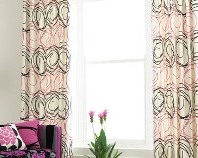The Whats and Hows of Suspended Lighting
 September 13, 2011
September 13, 2011 
Janet Ramin - You walk into a room, any room, and one of the things you take for granted is that there’s going to be light. When there’s light, everything not only looks brighter - it also looks bigger. Plus, with the right well-positioned light bulbs, a room can be transformed into an inviting place. With this much interior design riding on lighting, you really can’t take it for granted.
One of the easiest ways to throw ambient light around the whole room is to suspend a light fixture in the center of the space. Recessed lighting or track lighting also works, but this requires more ceiling height, expert labor, and time to install; in short, more money. Hence the popularity of hanging light fixtures, which have become a great do-it-yourself project for homeowners (see the video below for how to install a suspended light). Besides its relative value, suspended lighting has the ability to become a focus, a point of interest - definitely another decorating advantage.

For centuries, the only source of artificial light was flames from oil or candles. To this day, we still have light fixtures that look like candles even if electricity is being used to power them. To hold these candles, chandeliers or candelabrums as they were originally called, were created during the medieval period. They were simply made with outstretched wooden arms and at the end of each arm a small dish with a candle was placed. As time went by, chandeliers became more elaborate with multiple arms, added crystals, and carved decorations. An example of this is the traditional Chateau Chandelier (above) from Murray Feiss available on CSN Lighting.
If an elaborate chandelier is just too much for your space, but you need a light fixture for a traditionally-styled formal interior, the Savannah Chandelier from the Bethany collection is a pared-down version, more minimal but still an elegant piece (below, left). The arms and the intertwining vines have an Etruscan gold finish highlighted with hand-cut crystals. If you have a traditional interior with a rustic mood, you might try the Light Revolution Chandelier, a suspended light fixture from Forecast. The chandelier body is reminiscent of carriage wheels and evokes a country lodge atmosphere (below, right).

For more contemporary interiors, sleeker chandeliers have been designed using geometric-shaped arms rather than the traditional curved lines. The Margo chandelier from AF Lighting (below, left) has pyramid-shaped arms with cut crystal hanging off its points. The Odyssey chandelier has rectilinear arms and cylinder candle holders wrapped in leather (below, right).

In modern design, the use of chandelier arms have been in many instances completely eliminated as the light outputs have become stronger. This evolution has led to the use of a single bulb rather than multiple bulbs. Newer materials are also being employed as manufacturing techniques have improved. Designer George Kovacs uses alabaster, acrylics, or blown glass to create his polymorphic shaped lighting fixtures. The pendant light below uses concave alabaster panels that are translucent and allows light to shine through. The silver pendant light at right is made of shaped acrylic panels that are semi-transparent.

Thin layers of wood veneer have also been used to create unique housing for modern light fixtures. From Lzf Lamps, we have the Agatha suspended light (pictured at the top of the post), formed from twisted veneers that were dyed red. Another hanging light fixture from Lzf is the Japanese-inspired Mikado. Also made from wood veneers, the wood is further cut into thin strips and then twisted and fanned out to create a very dynamic and tension-filled sculptural object (see below). The unique cuts and piercing of Lzf fixtures result in an exciting play of light and shadow upon the room's surfaces.

When planning your lighting scheme and deciding on your ambient light source – take a look at the many different suspended light fixtures out there. There’s a style and mood and price point for all tastes and budgets.
Interested in learning more about lighting schemes? Take a look at Sheffield School's Complete Course in Interior Design. At Sheffield, you'll learn how to transform a space, create color schemes, and select furniture, lighting, and accessories.
 DIY,
DIY,  chandelier,
chandelier,  lighting,
lighting,  video in
video in  accessories
accessories 












Reader Comments (1)
Thanks for the advice! I've got a vintage birdcage I'm looking to modify so it fit a lightbulb...i know it'll look great once it's finished.